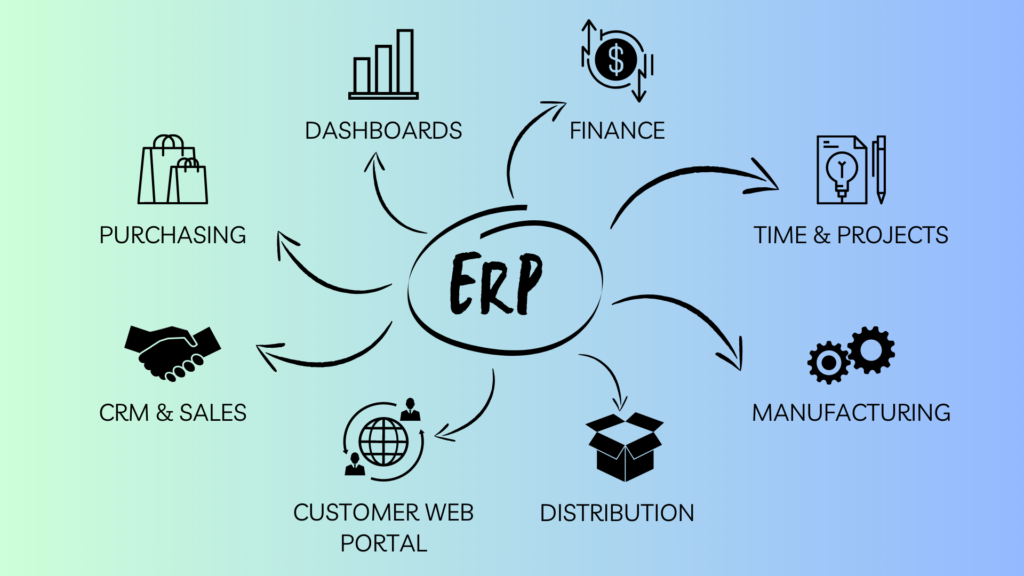Cloud ERP vs. Traditional ERP: Which is Right for Your Business?
Do you feel like you’re drowning in a sea of spreadsheets, software, and outdated processes? It seems that you need to consider implementing an ERP system and take another side.
According to a recent statistic from LinkedIn, over 70% of corporations use ERP software to streamline their processes and improve efficiency. But with so many options available, choosing the right ERP solution can feel like an overwhelming task.
This article will explore the differences between cloud and traditional ERP to help you decide which option is right according to your business needs. We’ll look at the pros and cons of each type of system, the factors you should consider when choosing between them, and provide tips on making the best decision for your organization.
What is an ERP system?
ERP (Enterprise Resource Planning) software allows you to manage and integrate your organization’s core business processes. These processes include finance, human resources, inventory, supply chain, customer relationship management (CRM), and more.
By using an ERP system, your business has a centralized system that helps streamline and automate all necessary business functions, making them more efficient, accurate, and cost-effective, improving collaboration across departments.
Why does your business need it?
Let’s consider the example of a small business owner named Steve. Initially, Steve had a small business, so he managed everything manually. However, as his business expanded and grew, he turned it into a large company with various departments like sales, accounting, marketing, and others. But keeping managing everything manually, Steve faces numerous challenges.
First, Steve cannot access real-time data. For instance, if he needs sales and budget data at the very moment, he must chase different people to get this information, which leads to inefficiencies and delays at his company.
Another issue Steve faces is the absence of integration between departments in his company. For instance, if the accounts payable department needs a purchase order from the purchasing team to compare invoices, they would have to contact the purchasing team and wait for them to send it. It is time-consuming and, again, leads to delays.
So, as we see, Steve’s business lacks a centralized system, leading to delays in processes, miscommunications between different departments, no access to live data, and a lack of internal control. These problems can hinder the business’ growth and success, as they cause inefficiencies, mistakes, and even fraud. This is where an ERP system comes in.

What is traditional ERP?
Traditional ERP is an Enterprise Resource Planning system that is installed locally on a company’s servers and IT infrastructure. Traditional ERP can refer to both on-premise ERP and hosted ERP, which are the two primary deployment options for traditional ERP systems.
- On-premise ERP is installed and runs on the customer’s own servers and IT infrastructure.
- Hosted ERP is installed and runs on a third-party provider’s servers and is accessed by the customer over the Internet.
Both of these deployment options fall under the category of traditional ERP, as they require on-site installation and configuration.
Traditional ERP systems often require powerful hardware, IT resources, and maintenance investment. An organization’s internal IT department or a third-party service provider typically manages and supports them. These systems offer a high degree of customization and control but can be costly and time-consuming to implement and maintain.
Examples of traditional ERP systems include SAP, Oracle E-Business Suite, Microsoft Dynamics AX, and Infor. For many years, large organizations have widely used these systems in various industries, such as manufacturing, healthcare, and finance.
For instance, the beverage giant Coca-Cola implemented a traditional ERP system to help manage its global supply chain and streamline its manufacturing and distribution processes. The automaker Ford Motor Company uses a traditional ERP system to manage its manufacturing processes and supply chain operations, from procurement to production to delivery.
What is cloud-based ERP?
Cloud ERP, also known as Software-as-a-Service (SaaS) ERP, is an Enterprise Resource Planning system deployed entirely in the cloud.
Unlike traditional ERP systems, which require on-premises hardware and software to run, cloud ERPs are entirely hosted in the cloud and can be accessed from anywhere with an Internet connection.
Cloud ERPs offer greater flexibility and scalability, as businesses can easily add or remove users and functionality as needed. They also provide real-time data and analytics, allowing companies to make fast and more informed decisions.
Cloud ERPs are often easier to use as they require less customization than traditional ERPs, making them a popular choice for small and mid-sized businesses. For instance, Dropbox, a file hosting service, uses cloud ERP to manage its financial operations, including accounts payable, accounts receivable, and general ledger. Or Shopify, an e-commerce platform, uses cloud ERP to manage its inventory, order fulfillment, and financials.
Using cloud ERP allows Shopify to manage its inventory and orders in real-time, giving a more accurate view of business operations. This real-time data also helps them make better decisions, as they can access up-to-date information about their sales and inventory levels. Additionally, cloud ERP allows Shopify to scale its business easier, as the system can handle large amounts of data and traffic without requiring additional hardware or IT resources.
Weighing the ERP benefits and drawbacks
As businesses grow and evolve, they are more likely to implement an Enterprise Resource Planning (ERP) system to manage their core business processes. Both ERP systems have pros and cons, and it is essential to look closely at them before choosing the right one for your business.
Benefits of traditional ERP
- Traditional ERP offers a higher level of data security and privacy than cloud ERP as the data is stored locally on the company’s own servers rather than in a remote location on the cloud;
- You might think: But the initial costs of traditional ERP are higher than cloud ERP. It is true. However, traditional ERP can be more cost-effective in the long run than cloud ERP as there are no monthly fees or ongoing expenses associated with cloud-based services;
- Traditional ERP is less dependent on the internet and can continue to operate even during internet outages or downtime, making it more reliable.
Challenges of traditional ERP
- The first challenge a business faces are the high upfront costs of purchasing and implementing the system. Traditional ERP systems require an investment in hardware and software plus hiring IT staff to set up and maintain systems, which can be challenging for small and medium-sized businesses;
- As a small manufacturing company grows, a traditional ERP system needs to be able to grow with it. It requires additional costs for server space, data storage, upgraded versions, training, and other scalability-related expenses;
- Limited accessibility is another drawback, as these systems are hosted on a company’s servers. You can only access them from the company’s physical premises, meaning remote access may be limited.
Benefits of cloud-based ERP
- Low upfront costs. Companies don’t need to purchase and maintain their own servers, hardware, or software, which can be expensive. Instead, they pay a subscription fee to use the software hosted and maintained by the ERP vendor;
- Accessing real-time data is also one of cloud erp benefits. With an internet connection, businesses can access real-time data from anywhere, anytime;
- Cloud ERP systems can be easily customized and configured to meet the specific needs of a business as the system is highly modular, allowing companies to add or remove modules as needed. Being hosted in the cloud, updates and upgrades are easier and quicker to implement, enabling businesses to keep their ERP systems up-to-date with the latest technology and features;
- Companies don’t have storage capacity limits;
- Setting up a cloud-based ERP system is a simple process – all you need to do is register with the cloud provider and make a few configurations, and it’s ready.
Challenges of cloud-based ERP
- Cloud ERP systems are vulnerable to internet-related risks, such as malware and man-in-the-middle attacks, as they rely on the internet for data transmission. However, most third-party providers have implemented robust security measures that are on par with, and sometimes even surpass, the security measures of small manufacturers;
- Since cloud-based ERP requires Internet connectivity, any issues with the Internet or network can cause disruptions in accessing the system;
- The lack of control over cloud computing entities means you must rely entirely on your cloud provider, which can lead to negative consequences if the provider experiences any issues. This dependence can affect your productivity and efficiency.
Cloud-based ERP vs. Traditional ERP: Which is the better choice for your business?
The final choice between these two deployment models of ERP will influence a business, including financial considerations, investment in IT infrastructure, deployment speed, scalability, and options for upgrades and customization.
A Traditional ERP system is a good fit for companies when:
- Companies require a high degree of customization and control over ERP solutions;
- Middle-sized and large enterprises with dedicated IT departments and robust infrastructure that can afford to purchase and the maintenance of ERP;
- Companies that deal with sensitive data, such as financial, government, or medical information, want to ensure greater security and compliance with industry regulations;
- Companies operating in remote or rural areas with limited internet connectivity may find using traditional ERP systems without an internet connection more practical;
On the other hand, a report by Softwarepath stated that nearly 97% of companies were contemplating adopting a cloud-based solution, proving that cloud-based ERP is becoming increasingly popular among companies.
Cloud-based ERP is an appropriate choice for the following companies:
- Startups and small businesses with a limited IT budget or no resources to purchase and maintain their own hardware and software. Moreover, cloud ERP vendors often offer flexible pricing plans that allow companies to scale their usage up or down as needed;
- Businesses that work remotely;
- Companies that need access to real-time information 24/7. Thus, multiple team members can simultaneously work on the same data from different locations;
- Businesses that plan to scale their operations quickly without worrying about investing in additional hardware or software. This is especially useful for businesses that experience rapid growth or seasonal spikes in demand;
- Businesses that want to stay up-to-date with the latest technology as cloud-based ERP systems are often updated automatically, ensuring that businesses always have access to the latest features and security updates.
Bottom line
Generally, companies may have various goals for ERP system implementation: streamlining processes, reducing costs, increasing the accuracy and visibility of data, enabling better decision-making, or improving customer service.
When it comes to choosing between cloud or traditional ERP, there is no one-size-fits-all solution. Both deployment models have benefits and drawbacks, and the decision ultimately comes down to each business’s specific needs and priorities.
Companies with limited budgets and IT resources but with a demand for flexibility and scalability may find cloud-based ERP the better option, while larger enterprises with more complex operations and a need for complete control over their ERP system may prefer traditional ERP.






